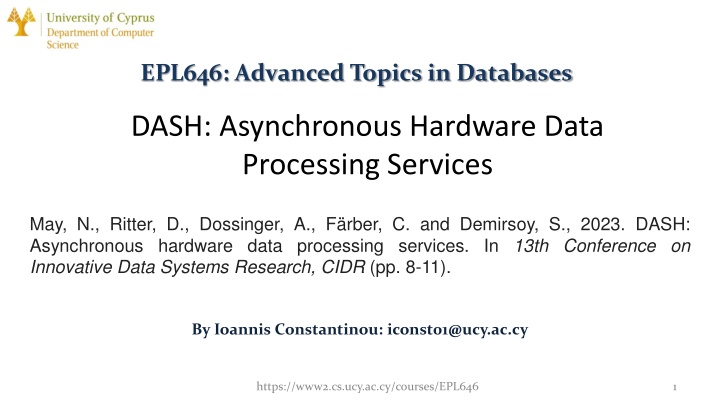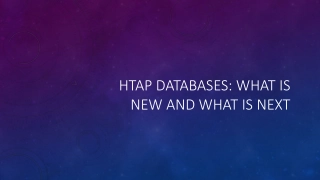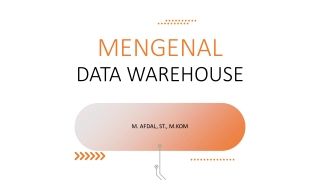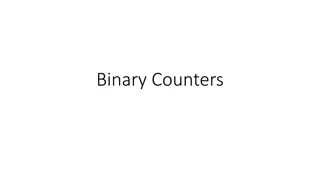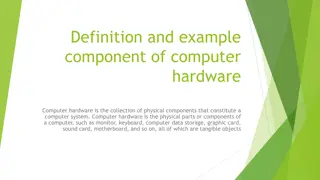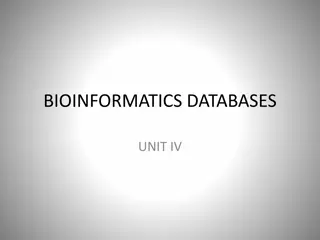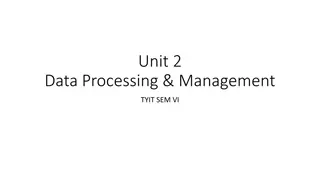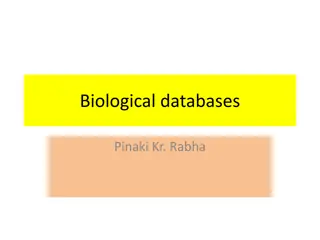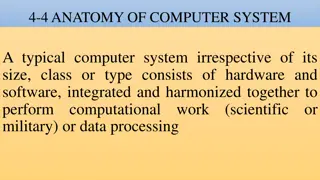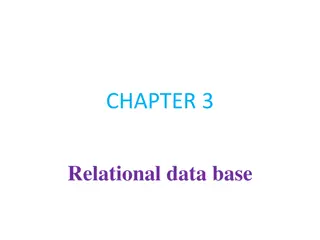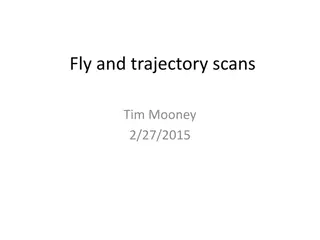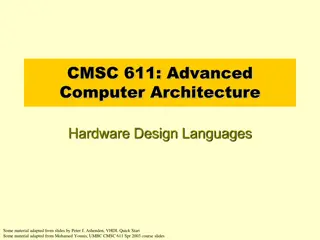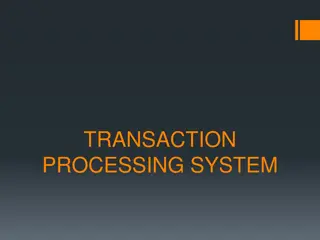Advanced Topics in Databases: Asynchronous Hardware Data Processing Services
Databases balancing performance and cost by offloading operations to HW accelerators, focusing on FPGAs available via cloud providers. Explore FPGA acceleration in database systems.
Uploaded on Feb 21, 2025 | 1 Views
Download Presentation

Please find below an Image/Link to download the presentation.
The content on the website is provided AS IS for your information and personal use only. It may not be sold, licensed, or shared on other websites without obtaining consent from the author.If you encounter any issues during the download, it is possible that the publisher has removed the file from their server.
You are allowed to download the files provided on this website for personal or commercial use, subject to the condition that they are used lawfully. All files are the property of their respective owners.
The content on the website is provided AS IS for your information and personal use only. It may not be sold, licensed, or shared on other websites without obtaining consent from the author.
E N D
Presentation Transcript
EPL646: Advanced Topics in Databases DASH: Asynchronous Hardware Data Processing Services May, N., Ritter, D., Dossinger, A., F rber, C. and Demirsoy, S., 2023. DASH: Asynchronous hardware data processing services. In 13th Conference on Innovative Data Systems Research, CIDR (pp. 8-11). By Ioannis Constantinou: iconst01@ucy.ac.cy 1 https://www2.cs.ucy.ac.cy/courses/EPL646
Introduction Databases need to have a good trade-off between high performance and cost One way to achieve this is by offloading compute- intensive operations from CPUs to HW-accelerators. In this research they focus on FPGAs which are becoming more widely available by cloud providers. https://www2.cs.ucy.ac.cy/courses/EPL646 2
Background and Related Work In general, cloud providers either employ FPGAs enclosed in their infrastructure or expose them as a service (FPGA-as-a-Service). Hence, this gives us the opportunity to use this kind of accelerators for database systems https://www2.cs.ucy.ac.cy/courses/EPL646 3
Background and Related Work Marked green, is a setup where the FPGA communicates with the CPU using PCIe or UPI interconnects which offers high bw and relatively low latencies Marked blue, is a setup where the FPGA is on the I/O path(network, memory or storage). Data transfer can be limited by latency or bandwidth of the interconnect and is considered a bottleneck. Marked red, is the focus of this research paper where the FPGAs are connected to the database via network links. This brings the notion of scaling and elasticity based on the workload. One use case here is compression of persistent data. https://www2.cs.ucy.ac.cy/courses/EPL646 4
Background and Related Work Marked green, is a setup where the FPGA communicates with the CPU using PCIe or UPI interconnects which offers high bw and relatively low latencies Marked blue, is a setup where the FPGA is on the I/O path(network, memory or storage). Data transfer can be limited by latency or bandwidth of the interconnect and is considered a bottleneck. Marked red, is the focus of this research paper where the FPGAs are connected to the database via network links. This brings the notion of scaling and elasticity based on the workload. One use case here is compression of persistent data. https://www2.cs.ucy.ac.cy/courses/EPL646 5
Background and Related Work Marked green, is a setup where the FPGA communicates with the CPU using PCIe or UPI interconnects which offers high bw and relatively low latencies Marked blue, is a setup where the FPGA is on the I/O path(network, memory or storage). Data transfer can be limited by latency or bandwidth of the interconnect and is considered a bottleneck. Marked red, is the focus of this research paper where the FPGAs are connected to the database via network links. This brings the notion of scaling and elasticity based on the workload. One use case here is compression of persistent data. https://www2.cs.ucy.ac.cy/courses/EPL646 6
FPGAs Challenges Over the years , FPGAs have become more available by providers as another option for acceleration like a GPU. This raises multiple challenges we must overcome like resource ceiling, reprogramming time, available interface bandwidth and difficulty of programming. https://www2.cs.ucy.ac.cy/courses/EPL646 7
DASH Architecture Database systems are split to compute and storage components Asynchronous Data Processing: The Offloading Coordinator gathers statistics of the db system and enqueues actions as HW tasks. The hardware task scheduler is responsible for scheduling the HW tasks and feeding stats to the offloading monitor The offloading monitor checks the efficiency and health of the finished HW task and can instruct the OC to take action.(e.g. Remove failing FPGAs) https://www2.cs.ucy.ac.cy/courses/EPL646 8
DASH Architecture This architecture allows for scalability and elasticity as it separates the FPGAs/Accelerators from the database system. To address concerns like security and cost of data transfers existing technologies that cloud providers have, can be used. https://www2.cs.ucy.ac.cy/courses/EPL646 9
DASH Use case: Compression-as-a- Service Implemented CaaS with DASH architecture on SAP HANA Cloud to evaluate DASH potential. By default SAP HANA uses the front coding technique on the critical path to compress. Used RePair compression technique in DASH to compress string dictionaries https://www2.cs.ucy.ac.cy/courses/EPL646 10
Front Coding and RePair Compression Figure is from: Lasch, R., Oukid, I., Dementiev, R. et al. Faster & strong: string dictionary compression using sampling and fast vectorized decompression. The VLDB Journal 29, 1263 1285 (2020). https://doi.org/10.1007/s00778-020-00620-x https://www2.cs.ucy.ac.cy/courses/EPL646 11
DASH Use case: Compression-as-a- Service 1 During the data processing of the db system, stats are collected about table sizes, number of unique values per column,etc The coordinator(shown before) decides to take action. 2 enqueues task in scheduler 3 the HW dequeues 4 and assigns a task to a function which starts taking data from 5a the data store 5b the data stream 6 the task collects statistics 7 and reports them to the scheduler https://www2.cs.ucy.ac.cy/courses/EPL646 12
Experimental Setup For FPGA, Docker container with CentOS and an FPGA bit-stream for the compression. Used the OpenCL programming language Extracted 4923 columns of type (N)VARCHAR and CLOB. Total 47GB uncompressed data. https://www2.cs.ucy.ac.cy/courses/EPL646 13
Results: RePair with FPGA vs Front Coding This results is to confirm that RePair is still better than front coding with new workloads https://www2.cs.ucy.ac.cy/courses/EPL646 14
Analysis of compression throughput Conclusion: RePair compression with DASH shows that network transfer is not a bottleneck and this task is mostly a compute-intensive operation. https://www2.cs.ucy.ac.cy/courses/EPL646 15
When to use RePair DASH for compression Observation: For shorter than 3-bytes average entry RePair DASH does not improve over front coding but for longer they achieve better results. Using this simple heuristic they showed that they reduced the memory consumption https://www2.cs.ucy.ac.cy/courses/EPL646 16
Cost Analysis of DASH RePair with front coding reduces memory consumption by 50% and RePair reduces by another 50% the remaining uncompressed data. At 100 MB/s it can compress 8.6TB of data per day Assuming two merge operations per day this corresponds to 4.3TB which will be reduced to 2.3TB with front-coding and to 1.075TB with RePair DASH. So based on the costs of using SAP HANA compared to an amazon f1 instance the savings are more than 13,000 euros. https://www2.cs.ucy.ac.cy/courses/EPL646 17
Conclusion and Future Research Main limitation of scaling with FPGAs is the tight coupling of them with the database systems They addressed this issue by designing a decoupled architecture, DASH, and basically creating this new perspective of FPGA-as-a-Service and showed the benefits of using this architecture using compression for string dictionaries They believe this setup could work to a wide range of database operations (Machine Learning, Graph or JSON processing). Future research is needed in terms of security, monitoring and more, to be able to apply this architecture to large-scale deployments. https://www2.cs.ucy.ac.cy/courses/EPL646 18
Thank you! https://www2.cs.ucy.ac.cy/courses/EPL646 19
